Marche is blue sea and white sandy beaches, rugged high mountains and green forests, rolling hills and fertile valleys, more than 3,000 years of history and culture, modern cities and medieval towns, northern Italian efficiency and southern Italian flair. The Marches are considered Italy in miniature, a scenic and human concentrate, and in a way this also applies to the wine scene. I was particularly excited by the renaissance of autochthonous grape varieties and the many different winemakers: the Moncaro cooperative bottles 7.5 million bottles a year and is also home to the Michelin-starred restaurant Le Busche. Winemaker Esther Hauser produces just 6,000 hand-picked bottles. In Montefeltro, the former entrepreneur Adriano Galli is building a modern showcase winery. He is reviving the wine-growing tradition of the area, which had been extinct for almost 100 years. Behind every winery is a face and often a story worth telling.
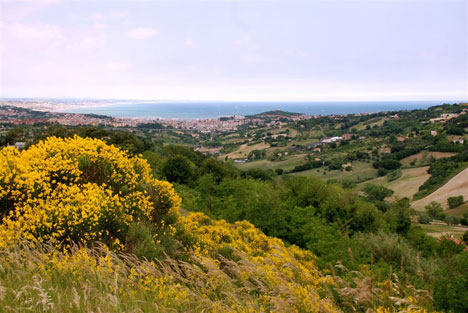
|
| The Marche region lies south of Rimini on the Italian Adriatic coast (Photo: J. Kaiser) |
Lacrima di Morro d'Alba is an autochthonous grape variety that should not be confused with the sweet Lacryma Christi, which achieved a sad notoriety in the 1960s. Lacrima di Morro is a red grape variety, Lacryma Christi is available in white or red. Because of its intense bouquet, it is suspected that Lacrima di Morro, like Lacrima Christi, could be a variety or mutation of the equally very fragrant Aleatico grape, which is widespread in Italy. In the VITIS International Variety Catalogue, Lacrima Christi appears as a synonym for Aleatico, but Lacrima di Morro does not.
Lacrima means tear. The Lacrima grape is packed with tightly packed berries. When the berries ripen, it gets really tight in the bunch. The berries press against each other, the berry skin cracks, juice flows out of small cracks, the berries tear. To the delight of birds, insects and mould, to the winegrower's delight. A difficult grape variety that truly deserves its name. Lacrima may be vinified dry and sweet. To emphasise fragrance and fruit, the basic Lacrima is often fermented with carbonic maceration (Macerazione Carbonica). For Superiore, maceration and wood ageing are usually used. Juice extraction (saignée) is also carried out to produce even denser wines and, as a by-product, rosé. The wines produced from dried grapes in the Amarone style are the most interesting version for many wine lovers: True "nose wines", beguilingly fragrant and aromatic. Since Lacrima has only average acidity levels, the fruit that is so concentrated can seem soft and washed out. In successful examples, on the other hand, a monumental whirlwind sweeps through the nose and palate.
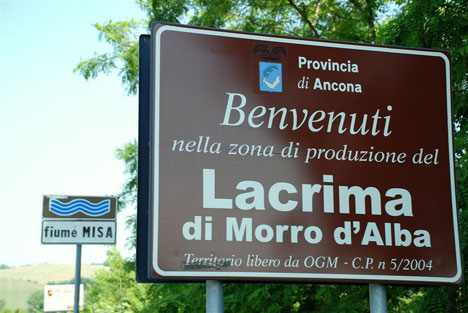
|
| DOC Lacrima di Morro d'Alba% the tear from Morro d'Alba (Photo: J. Kaiser) |
The centre of the DOC Lacrima is the village of Morro d'Alba, about 30 kilometres west of Ancona. But many winegrowers outside have also bought land in the DOC, because Lacrima enjoys great popularity in Morro d'Alba restaurants. The dry versions go well with strong meat, and the sweet passito goes well with dessert or cheese. Because the locals mostly drink their own Lacrima, you rarely see it outside the Marche.
I liked Mario Lucchetti's Lacrimae best - from the basic wine to the Passito, they are all very nice wines. The 2009 with typical violet and rose scents, with forest fruits and a slight astringency on the palate perfectly accompanied the excellent lamb chops at the Vincanto restaurant in Jesi. Also recommended are the Lacrimae from Luciano Landi, Moncaro, Marotti Campi, and from Velenosi. All of them are typical representatives of which one likes to drink a glass neat or with a piece of chocolate.
If you are already at Marotti Campi and want to taste wines outside the mainstream, you should definitely try the "Dondere". It consists of half Petit Verdot and a quarter each of Montepulciano and Cabernet Sauvignon. The 2008 is absolutely dry, the tannins still a bit rough, much too young, I would like to have it in my glass in ten years.
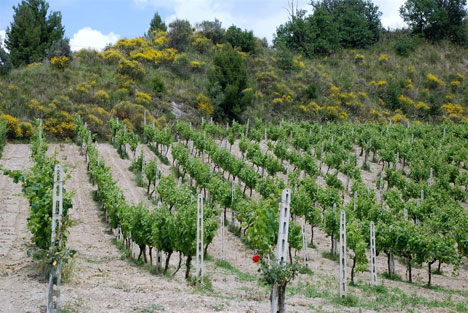
|
| Vineyards near Ascoli Piceno (Photo: J. Kaiser) |
Another autochthonous variety is Pecorino. Its name is possibly related to the wanderings of shepherds and their flocks of sheep in the region. The "sheep grape" is a very old grape variety that was cultivated mainly for its early ripeness. Because it produces unreliable yields, it fell into oblivion. Another difficult grape variety, whose area has only grown again to about 200 hectares today thanks to the perseverance of some winegrowers. Typical is a fine, but not exuberant fruit in the nose, often reminiscent of orange zest and flowering broom. In the mouth, the lively acidity and the firm structure are immediately noticeable. No wonder that many Pecorino wines also present themselves well as companions to young Pecorino cheese. The small village of Offida, about 15 kilometres northeast of Ascoli Piceno, gives its name to the DOC Offida Pecorino, from which the best wines come.
One of those stubborn winegrowers who preferred quality to quantity in the bottle was Domenico Capecci from the Podere Capecci San Savino winery. He was probably the first to bring pure Pecorino to the market. He has been planting Pecorino seedlings at ungrafted since 1990. Despite its youth, the 2010 "Ciprea" is already a very impressive wine, extremely complex, yellow-fruity, with warmth a discreet sage aroma develops, despite its fullness, the wine dances on the tongue.
Perhaps the most independent Pecorino is made by the Aurora winery. The five winegrowers have been cultivating their vineyards organically for over 20 years, and biodynamically for the last two years. Their wines taste as good as the land they cultivate. The 2009 "Fobbio" is an uncompromising wine. In the mouth it seems very robust at first, but not at all clumsy, it fills the mouth completely without seeming heavy. A shepherd with a university degree!
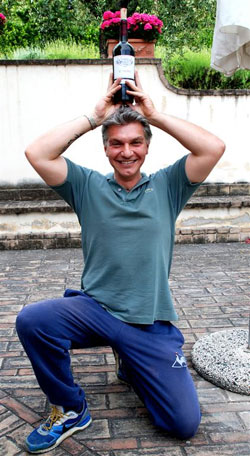
|
| Filippo Panichi of Seghetti Panichi% Winemaker with body and soul - and humour (Photo: J. Kaiser) |
If you're already in the area, it's worth taking a short hop across the "border" into the neighbouring province of Teramo, which is in the Abruzzo region. In Controguerra, Dino Illuminati produces a very good Colli Aprutini Pecorino IGT. In the village of Atri, Villa Medora produces a fine Pecorino Terre di Chieti. Another nice Terre di Chieti is the "Vellodoro" from Umani Ronchi. Although the large company is based in Osimo in Ancona in the Marche, it cultivates vineyards in several growing areas in the Marche and Abruzzo.
The Pecorino "Verdone" from Tenuta Seghetti Panichi is particularly recommendable: very typical, not a powerhouse, but also not a weakling, a real fun wine. Filippo Panichi, the owner of the winery, is unique, a winemaker with heart and soul. He produces not only good Pecorino, but also other wines with a price-pleasure ratio that is hard to beat. The winery was founded as early as 1896. If you are in the area, you should definitely take the opportunity to visit it. The ingenious cellar architecture of the time, with wind tunnels and other structural peculiarities, is well worth seeing.
With so much praise, it comes as no surprise that Pecorino is also excellent in cuvées. The most important blending partners are Trebbiano and Passerina. Trebbiano is Italy's most cultivated white grape variety and produces wines that are relatively rich in acidity but often lack structure. Like Pecorino, Passerina is autochthonous to the Marche and neighbouring regions. It produces fresh wines with good acidity. Even single-varietal, dry or sweet as passito, Passerina wines are a lot of fun to drink. However, none of the single-varietal Passerinas I tasted reached the substance of the top Pecorinos.
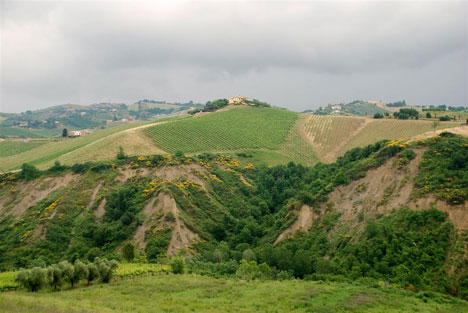
|
| Pecorino Land% Vineyards and broom near Offida (Photo: J. Kaiser) |
Good examples are Aurora's "Falerio" (50% Trebbiano, 30% Passerina, 20% Pecorino) and Panichi's "La Spiga" (50%, 25%, 25%), both Falerio dei Colli Ascolani DOC. The wines could hardly be more different, despite almost the same proportions of grape varieties. Both are fresh wines, but the "La Spiga" shows citrus and apple notes, while the "Falerio" has tropical fruit and tobacco notes.
The "Serrabianco" from the Colli di Serrapetrona winery is also exciting. It consists of half Pecorino and half Sauvignon Blanc; lots of fruit, very drinkable, but by no means a banal drinking pleasure.
The village of Serrapetrona gives its name to the small DOCG area of Serrapetrona. Still wine and Spumante are produced from another autochthonous vine, the Vernaccia Nera. The red variety, as "Nera" already says, has nothing to do with the white Vernaccia and also nothing to do with other red Vernaccia or with Vernatsch. The DOCG stipulates that at least 40 percent of the grapes must be dried before fermentation. Usually, the mash of the dried grapes is added to the young red wine in January of the following year, and another fermentation starts. The red Spumante made from this initial wine is therefore probably the only sparkling wine in the world that has undergone three fermentations. Most producers want to move away from pure spumante production and now also make still wines.
The 2009 Serrapetrona secco from the Alberto Quacquarini winery is a very good, typical representative of this type of spumante: fine perlage, a beautiful wild berry-fruity nose, blackberry, cherry, very light apple, a hint of bitter almond and even a very subtle leather note in the mouth. It calls itself secco, but it is certainly not completely dry, yet charming and drinkable. The Serrapetrona dolce is more fragrant on the nose, but sweetness dominates in the mouth. It reminds me of my Krimsekt youthful sins, but in a much better class.
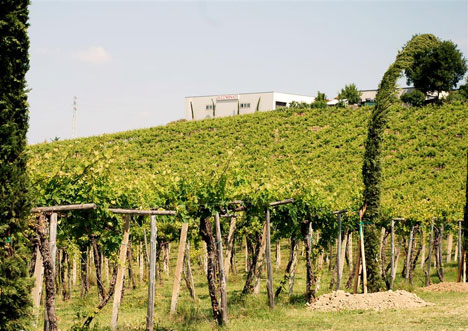
|
| Dino Illuminati Winery in Controguerra% Abruzzo (Photo: J. Kaiser) |
I also liked the dry still wines from Quacquarini, especially the 2006 "Petronio", aged for 24 months in barriques and made from 100 percent grapes that have been dried for two months. Despite all its power, the wine seems restrained and will certainly need a few more years to optimally integrate fruit and wood. The 2007 "Colli di Serrapetrona" IGT, made from 25 percent each of Vernaccia, Sangiovese, Merlot and Cabernet Sauvignon, is already a joy to drink.
The dry wines from the aforementioned Colli di Serrapetrona winery are also excellent. The 2008 "Collequanto" is perfect to drink now, very round and long. If you have tasted the Spumante before, the presence of the tannins is surprising. The "Robbione", like the "Petronio", is made from 100 percent grapes dried for two months. The 2006 is an aristocratic wine, even denser and more complex than the "Collequanto", and in it the wood makes itself felt through a fine herbal spiciness. In the "Somno", the grapes were dried to a weight loss of three quarters. The 2007 is sweet, dried fruit-fruity, spicy, peppery. The sweetness is balanced not only by the acidity but also by the tannins. In this respect, the "Somno" is stylistically reminiscent of the sweet Tannat wines, although the fruit characteristics are quite different.
Interesting wines can also be found at the Fattoria Mancini in Pesaro. The main grape variety of this family winery is Pinot Noir, and has been since 1861, after the Napoleonic administration had already introduced Pinot Noir to the region.
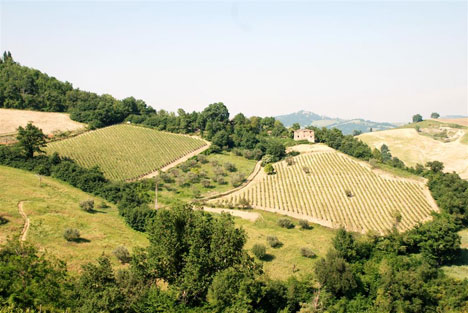
|
| The wine comes back to Montefeltro (Photo: J. Kaiser) |
The "Focara Pinot Noir" comes from a steep slope directly on the Adriatic Sea. The 2009 wine clearly shows the Burgundian model, the use of wood is fortunately discreet in the background. Interesting is the "Blu", a blue-black wine from old Ancelotta vines with 15 percent Pinot Noir. A wine to colour your teeth, but not as weighty as you might expect from the colour. I really liked the 2010 "Roncaglia", a cuvée of 75 percent Albanello and 25 percent white Pinot Noir: fragrant, fresh and a minerality almost reminiscent of a Manzanilla sherry.
The La Maddalena winery in Monterado, idyllically situated in a small valley, looks as if it has been made from scratch, even from afar. No wonder, since it belongs to the Swiss couple Maria Magdalena Schlegel and Carlo Otto Früh. "Precise" was the first association I spontaneously had with the wines.
I particularly liked the "Flirt", the "Carletto" and the "Il Ricco Rosso". The "Flirt" is a white Sangiovese, not a great wine, but a drinkable drop that I can imagine as a very good accompaniment to fish and seafood. The 2007 "Carletto", made from three quarters Cabernet Sauvignon and one quarter Merlot, convinces above all with its fullness and fruit. The 2008 "Il Ricco Rosso" consists of 78 percent Merlot and 22 percent Cabernet Sauvignon and is aged for 18 months in barriques. If you want it even denser and more powerful, you should try the "Il Ricco Rosso 100" (100% Merlot) or the "Carletto 100" (100% Cabernet Sauvignon).
The Terracruda winery in Fratte Rosa is run by a very young and eager team. They have concentrated on three varieties. The Bianchello del Metauro DOC usually produces light, fresh white wines that are best drunk young. Terracruda's "Campodarchi", which is partly matured in barriques with intensive bâtonnage, shows that it can be done differently. The 2006 has a lot of melting, the wood can hardly be tasted anymore. The Sangiovese (Colli Pesaresi DOC) from Terracruda show that the grape variety does not only produce excellent results in Tuscany. The Vernaccia di Pergola (Pergola Rosso DOC) is a variety of Aleatico. Both the 2008 "Ortaia" and the "Lubaco" are aged for 12 to 18 months in barriques, whereby in the case of the "Lubaco" the grapes are selected again after the harvest and new wood is used. The two wines are very similar: once you take them out of the bottle, they literally explode in the glass. Due to the wood ageing, the "Lubaco" appears more complex and at the same time even more balanced; it certainly goes well with strong grilled meat, dishes with fruity sauces or intense spices, e.g. with a not too spicy lamb curry.
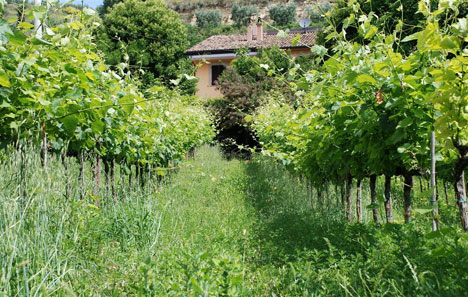
|
| Winery Oasi Degli Angeli% Cupra Marittima (Photo: J. Kaiser) |
I already mentioned Adriano Galli's Valturio winery. With great Sangiovese wines, the thought of Brunello is obvious, but with Adriano's "Valturio", a new star has appeared in the Sangiovese sky. It consists of 100 per cent Sangiovese from three different clones, 7,000 vines per hectare, grown at 450 to 550 metres above sea level in the Albarello system. After fermentation, the wine is aged for 12 months in barriques and a further 12 months in bottle. The result is an exceptionally lively wine, multi-layered and of playful elegance. The "Solco", which is produced from the Rebo grape, is also exciting. Rebo is a new variety of Merlot and Teroldego from the San Michele all'Adige Wine Institute and is mainly cultivated in Trentino. The 2008 is already round and very drinkable.
With minimal technology but great dedication, Esther Hauser produces about 6,000 bottles a year in Staffolo: "Il Cupo", a single-varietal Montepulciano, and "Il Ceppo" a cuvée of Montepulciano, Sangiovese and Cabernet Sauvignon. Their vineyard is situated on a slope above the Esino valley, and on clear days you have a dreamlike view all the way to the coast, 25 kilometres away. Both wines need air to develop, but even the waiting time is a pleasure. The 2007s develop an ethereal fragrance, with notes of cassis and mulberry in the case of "Il Ceppo", and dark berry with hints of orange oil in the case of "Il Cupo". In the mouth, both wines appear very elegant despite all their power and structure.
Marco Casolanetti from the Oasis Degli Angeli winery in Cupra Marittima also produces exceptional red wines. He too has only two wines, the "Kupra" from very old Grenache vines and the "Kurni" from Montepulciano, a total of around 5,000 bottles. I was particularly taken with the 1999 "Kurni", which I was able to taste from the magnum opened the day before. An aristocratic, a great wine, wonderful to drink now, which will probably stay at this level for years to come.
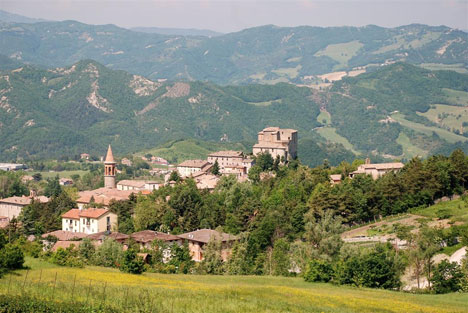
|
| Sant'Agata Feltro% Capital of the white truffle (Photo: J. Kaiser) |
Verdicchio, Marche's most famous vine, is well enough known. Nevertheless, one wine should not go unmentioned. I had the pleasure of tasting the 2007 Verdicchio di Castelli di Jesi from Villa Bucchi with Claudia Bucci: complex and powerful, vibrant with a long finish, very elegant and tremendously fun to drink for such a powerful wine.
If you are already in Montefeltro, you should plan a detour to Sant'Agata Feltria. The village of 2,300 inhabitants is a stronghold of truffle hunters. In autumn, during the truffle season, the otherwise quiet village awakens and becomes a culinary boomtown. But you can also buy excellent truffle products out of season.
Cherry wine, visciole, is a popular liqueur in the Marche, made from wild cherries, sugar and wine. Those who enjoy the famous cherry chocolates are sure to like it. Marche's most famous son, Frederico da Montefeltro, general and patron of the arts in the 15th century, was a great friend of visciole.
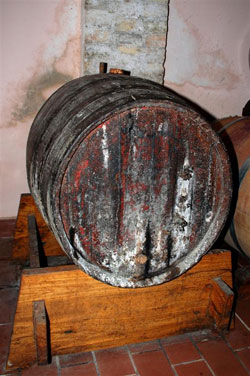
|
| Vino cotto barrel from 1918 in the Cantina Rasicci% Controguerra (Photo: J. Kaiser) |
Many other winemakers and their wines would also have been worth mentioning. It is worth leaving the beaten track and digging for local wine treasures away from the well-known Italian areas. The Marche and neighbouring regions are the best example.
All recently tasted wines from the Marche region in the wine guide